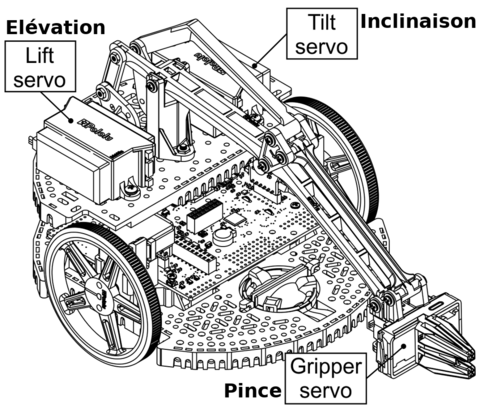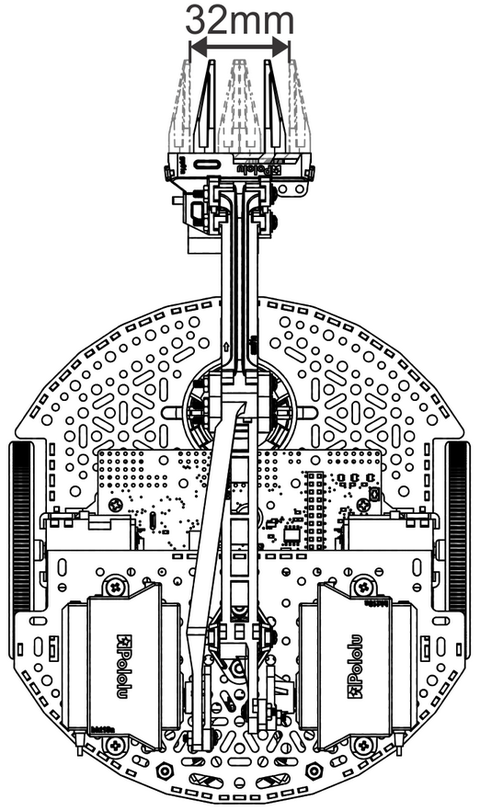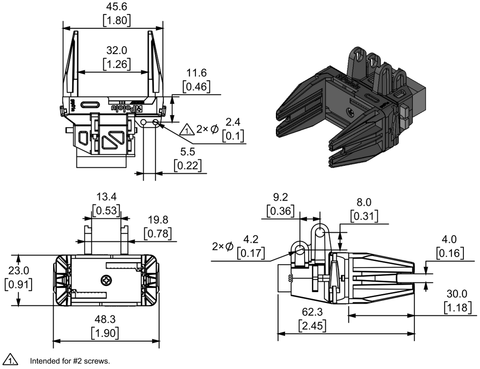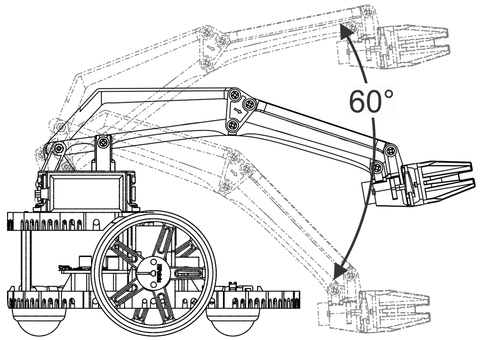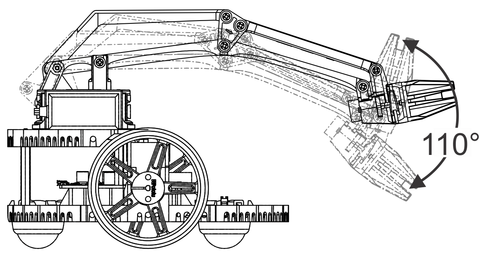Différences entre versions de « Pololu-Romi-Arm-Utiliser »
| Ligne 3 : | Ligne 3 : | ||
== Première expérience avec les servo? == | == Première expérience avec les servo? == | ||
| − | Les servo hobby | + | Les servo hobby sont de petits actuateurs modulaires développé pour fonctionner avec des systèmes radio commandés (RC Radio). Ce sont des produits de l'industrie du Hobby pour des bateaux miniatures, direction de voitures télécommandée, les flaps d'avions radio-commandée, jouet parachutiste et mécanismes divers. |
Si vous êtes nouveaux venus dans le monde des servos, cette petite série d'articles de blog vous permettra de vous familiariser avec le différents types de servo, comment ils fonctionnent et comment les contrôler. | Si vous êtes nouveaux venus dans le monde des servos, cette petite série d'articles de blog vous permettra de vous familiariser avec le différents types de servo, comment ils fonctionnent et comment les contrôler. | ||
Version du 9 novembre 2021 à 12:34
Première expérience avec les servo?
Les servo hobby sont de petits actuateurs modulaires développé pour fonctionner avec des systèmes radio commandés (RC Radio). Ce sont des produits de l'industrie du Hobby pour des bateaux miniatures, direction de voitures télécommandée, les flaps d'avions radio-commandée, jouet parachutiste et mécanismes divers.
Si vous êtes nouveaux venus dans le monde des servos, cette petite série d'articles de blog vous permettra de vous familiariser avec le différents types de servo, comment ils fonctionnent et comment les contrôler.
- Introduction aux servos (Pololu, Anglais)
- Introduction aux Servo (2) (Pololu, Anglais)
- Sélectionnez votre servo (Pololu, Anglais)
- Servo, servo moteur, servomoteur (Pololu, Anglais)
- Caractéristique électrique des servo et introduction à l'interface de contrôle servo (Pololu, Anglais)
- Interface de contrôle Servo en détails (Pololu, Anglais)
- Approche matérielle simple pour commander un servo (Pololu, Anglais)
- Approche microcontrôleur pour commander un servo (Pololu, Anglais)
- Contrôle avancé d'impulsion en utilisant le générateur PWM matériel (Pololu, Anglais)
- Contrôle avancé d'impulsion en utilisant un timer et intérruption (Pololu, Anglais)
- Contrôle de vitesse de servo en RC (Radio Commande) (Pololu, Anglais)
- Servo à rotation continue et servo multi-tours (Pololu, Anglais)
Vue d'ensemble
|
|
En cours de traduction/élaboration. |
The Robot Arm Kit for the Romi comes with one micro servo for the gripper and two standard-sized servos for moving the arm. All three of these servos are specially modified with an additional wire that gives access to the potentiometer feedback inside the servo. The micro gripper on the end of the arm uses a rack and pinion design with the pinion gear mounted to the servo spline and opposing racks to keep the gripper paddles synchronized and parallel to each other throughout the range of motion. Lifting an object will generally cause the Romi to tilt forward, so we highly recommend using the optional second ball caster in the front of the Romi. Additionally, using a rubber band to increase the stiffness of the built-in suspension on the une bille en roue libre avant (optionnelle) can help stabilize the robot. The recommended maximum payload of the arm is 3.5 oz (100 g).
Alimenter les servos
All three of the servos have a nominal operating voltage of 4.8 V to 6 V. The larger lift and tilt servos can briefly draw up to around 1.8 A each when commanded to move abruptly, but the typical current draw should be under an amp each. The stall current of the micro gripper servo is approximately 0.8 A at 6 V.
The Romi chassis has multiple power options built into the battery compartment, as discussed in Options d'alimentation of the Romi Chassis User’s Guide. If you are using the 4 battery configuration with the Romi chassis, you can power the servos from the battery voltage. Please note that using all six batteries in series can result in voltages upwards of 9 V with fully-charged NiMH batteries, so you should not power your servos directly from the batteries in this configuration. In this case you can use a step-down voltage regulator from Pololu such as our "6V, 2.5A Step-Down Voltage Regulator D24V22F6" lien pololu to safely power the servos.
| If you use the "Power Distribution Board for Romi Chassis" lien pololu, it defaults to getting power from all six batteries, but it can be reconfigured to be powered from four cells; see the board’s product page for more information. |
Amplitude de mouvement et signaux de contrôle
Each of the servos used by the Robot Arm Kit for Romi has a different effective range of motion due to the arm’s geometry. Please note that it is possible to drive the servos in a way that they physically bind the arm and cause them to “fight” each other, which could result in damage to servos or the Robot Arm. Most servos are intended to be used with the 1000 µs to 2000 µs pulse width range commonly used in RC systems; however, many of them can accept a wider range of inputs and will continue responding to them accordingly (moving farther and farther from neutral until they hit their mechanical limits and possibly destroy themselves). The Robot Arm accessory takes advantage of this increased range for the gripper servo. If you followed the assembly instructions correctly, the full range of motion of the gripper servo should correspond to pulse widths from about 500 µs (fully open) to 2400 µs (fully closed). Please note that there could be some unit-to-unit variation in the servos, so if you notice some buzzing when there is no load on the servo, you might try adjusting these values.
Similarly, based on the assembly instructions, the full range of the lift servo should be from 1000 µs (fully raised) to 1900 µs (fully lowered), and the full range of the pivot servo should be from 1200 µs (fully down) to 1900 µs (fully up). Again, this might differ slightly due to unit-to-unit variation in the servo.
Basé sur "Guide utilisateur du bras Romi" de Pololu (https://www.pololu.com/docs/0J76) - Traduit en Français par shop.mchobby.be CC-BY-SA pour la traduction
Toute copie doit contenir ce crédit, lien vers cette page et la section "crédit de traduction". Traduit avec l'autorisation expresse de Pololu (www.pololu.com)
Based on "Pololu Romi Arm User’s Guide" from Pololu (https://www.pololu.com/docs/0J76) - Translated to French by shop.mchobby.be CC-BY-SA for the translation
Copies must includes this credit, link to this page and the section "crédit de traduction" (translation credit). Translated with the Pololu's authorization (www.pololu.com)
